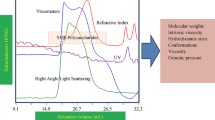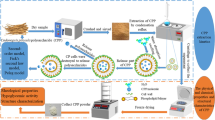Abstract
The extraction temperature had a significant impact on the concentration of polysaccharides derived from solid-liquid extraction of Spirulina. The polysaccharide concentration was significantly higher when the extraction was performed at 90°C than when it was performed at 80, 70, and 50°C. This result is related to the diffusion coefficients of the polysaccharides, which increased from 1.07 × 10−12 at 50°C to 3.02 × 10−12 m2/sec at 90°C. Using the Arrhenius equation, the pre-exponential factor (D 0 ) and the activation energy (E a ) for Spirulina polysaccharide extraction were calculated as 7.958 × 10−9 m2/sec and 24.0 kJ/mol, respectively. Among the methods used for the separation of Spirulina polysaccharides, cetyltrimethylammonium bromide (CTAB, method I) and organic solvent (ethanol, in methods II and III) provided similar yields of polysaccharides. However, the separation of polysaccharides using an ultrafiltration (UF) process (method III) and ethanol precipitation was superior to separation via CTAB or vacuum rotary evaporation (method II). The use of a membrane with a molecular weight cut-off (MWCO) of 30 kDa and an area of 0.01 m2 at a feed pressure of 103 kPa with a mean permeate flux of 39.3 L/m2/h and a retention rate of 95% was optimal for the UF process. The addition of two volumes (v/v) of ethanol, which gave a total polysaccharide content of approximately 4% dry weight, was found to be most suitable for polysaccharide precipitation. The results of a Sepharose 6B column separation showed that the molecular weights of the polysaccharides in fractions I and II were 212 and 12.6 kDa, respectively.
Similar content being viewed by others
References
Wijesinghe, W. A. J. P. and Y. J. Jeon (2012) Biological activities and potential industrial applications of fucose rich sulfated polysaccharides and fucoidans isolated from brown seaweeds: A review. Carbohydr. Polym. 88: 13–20.
Parikh, A. and D. Madamwar (2006) Partial characterization of extracellular polysaccharides from cyanobacteria. Bioresour. Technol. 97: 1822–1827.
Cohen, Z. (1997) The Chemical of Spirulina. pp. 175–204. In: A. Vonshak (ed.). A Spirulina platensis (Arthrospira): Physiology, cell-biology and biotechnology. Taylor & Francis Inc., Philadelphia, USA.
Plaza, M., M. Herrero, A. Cifuentes, and E. Ibáñez (2009) Innovative natural functional ingredients from microalgae. J. Agric. Food Chem. 57: 7159–7170.
Chirasuwan, N., R. Chaiklahan, M. Ruengjitchatchawalya, B. Bunnag, and M. Tanticharoen (2007) Anti HSV-1 activity of Spirulina platensis polysaccharide. Kasetsart J. Nat. Sci. 41: 311–318.
Yang, L., Y. Wang, Q. Zhou, P. Chen, Y. Wang, Y. Wang, T. Liu, and L. Xie (2009) Inhibitory effects of polysaccharide extract from Spirulina platensis on corneal neovascularization. Mol. Vis. 15: 1951–1961.
Pugh, N., A. S. Ross, N. H. ElSohly, A. M. ElSohly, and S. D. Pasco (2001) Isolation of three high molecular weight polysaccharide preparations with potent immunostimulatory activity from Spirulina platensis, Aphanizomenon flos-aquae and Chlorella pyrenoidosa. Planta Med. 67: 737–742.
Majdoub, H., B. M. Mansour, F. Chaubet, S. M. Roudesli, and M. R. Maaroufi (2009) Anticoagulant activity of a sulfated polysaccharide from the green alga Arthrospira platensis. Biochim. Biophys. Acta 1790: 1377–1381.
Hayashi, T. and K. Hayashi (1996) Calcium spirulan, an inhibitor of enveloped virus replication, from a blue-green alga Spirulina platensis. J. Nat. Prod. 59: 83–87.
Lee, J. B., T. Hayashi, K. Hayashi, U. Sankawa, M. Maeda, T. Nemoto, and H. Nakanishi (1998) Further purification and structural analysis of calcium spirulan from Spirulina platensis. J. Nat. Prod. 61: 1101–1104.
Lee, J. B., T. Hayashi, K. Hayashi, and U. Sankawa (2000) Structural analysis of calcium spirulan (Ca-SP) -derived oligosaccharides using electrospray ionization mass spectrometry. J. Nat. Prod. 63: 136–138.
Certenbach, D. D. (2002) Solid-liquid extraction technologies for manufacturing nutraceuticals from botainical. pp. 331–366. In: J. Shi, G. Mazza, and M. Le Maguer (eds.). Functional foods: Biochemical and processing aspects. CRC Press Inc., Boca Raton, Florida, USA.
Aguiler, J. M. (2003) Solid-liquid extraction. pp. 35–55. In: C. Tzia, and G. Liadakis (eds.). Food Optimization in Food Engineering. Marcel Dekker, NY, USA.
Cacace, J. E. and G. Mazza (2003) Mass transfer process during extraction of phenolic compounds from milled berries. J. Food Eng. 59: 379–389.
Loncin, M. and R. L. Merson (1979) Food engineering. Principles and selected applications. p. 494. Academic Press Inc., NY, USA.
Abdel-Kader, Z. M. (1991) A study of the apparent diffusion coefficient for ascorbic acid losses from pea during blanching in water. Food Chem. 40: 137–145.
Peng, L., H. C. Hocart, W. J. Redmond, and E. R. Williamson (2000) Fractionation of carbohydrates in Arabidopsis root cell walls shows that three radial swelling loci are specifically involved in cellulose production. Planta 211: 406–414.
Azeredo, J. and R. Oliveira (1996) A new method for precipitating bacterial exopolysaccharides. Biotecnol. Technol. 10: 341–344.
Hasui, M., M. Matsuda, K. Okutani, and S. Shigeta (1995) In vitro antiviral activities of sulfated polysaccharides from a marine microalga (Cochlodinium polykrikoides) against human immunodeficiency virus and other enveloped viruses. Int. J. Biol. Macromol. 17: 293–297.
Zha, X. Q., J. J. Xiao, H. N. Zhang, J. H. Wang, L. H. Pan, X. F. Yang, and J. P. Luo (2012) Polysaccharides in Laminaria japonica (LP): Extraction, physicochemical properties and their hypolipidemic activities in diet-induced mouse model of atherosclerosis. Food Chem. 134: 244–252.
Cai, W., X. Gu, and J. Tang (2008) Extraction, purification, and characterization of the polysaccharides from Opuntia milpa alta. Carbohydr. Polym. 71: 403–410.
Wei, X., M. Chen, J. Xiao, Y. Liu, L. Yu, H. Zhang, and Y. Wang (2010) Composition and bioactivity of tea flower polysaccharides obtained by different methods. Carbohydr. Polym. 79: 418–422.
Sheng, J., F. Yu, Z. Xin, L. Zhao, X. Zhu, and Q. Hu (2007) Preparation, identification and their antitumor activities in vitro of polysaccharides from Chlorella pyrenoidosa. Food Chem. 105: 533–539.
Challouf, R., L. Trabelsi, B. R. Dhieb, E. O. Abed, A. Yahia, K. Ghozzi, B. J. Ammar, H. Omran, and B. H. Ouada (2011) Evaluation of cytotoxicity and biological activities in extracellular polysaccharides released by cyanobacterium Arthrospira platensis. Braz. Arch. Biol. Technol. 54: 831–838.
Chaiklahana, R., N. Chirasuwan, P. Triratana, V. Loha, S. Tia, and B. Bunnag (2013) Polysaccharide extraction from Spirulina sp. and its antioxidant capacity. Int. J. Biol. Macromol. 58: 73–78.
Chaiklahan, R., N. Chirasuwan, V. Loha, and B. Bunnag (2008) Lipid and fatty acids extraction from the cyanobacterium Spirulina. ScienceAsia 34: 299–305.
Crank, J. (1975) The Mathematics of Diffusion. 2nd ed., pp. 89–102. Oxford University Press, Ely House, London.
Ramesh, P. H. and R. N. Tharanathan (1999) Water-extracted polysaccharides of selected cereals and influence of temperature on the extractability of polysaccharides in sorghum. Food Chem. 64: 345–350.
Dubois, M., K. A. Gilles, J. K. Hamilton, P. A. Rebers, and F. Smith (1956) Colorimetric method for determination of sugars and related substances. Anal. Chem. 28: 350–356.
Mulet, A., A. Berna, V. Heredero, and C. Rossello (1988) Temperature influence on the sugar extraction from carob pods. Lebensm. Wiss. Technol. 21: 108–112.
Pinelo, M., J. Sineiro, and M. J. Núñez (2006) Mass transfer during continuous solid-liquid extraction of antioxidants from grape byproducts. J. Food Eng. 77: 57–63.
Türker, N. and F. Erdo du (2006) Effects of pH and temperature of extraction medium on effective diffusion coefficient of anthocynanin pigments of black carrot (Daucus carota var. L.). J. Food Eng. 76: 579–583.
Arroqui, C., T. R. Rumsey, A. Lopez, and P. Virseda (2002) Losses by diffusion of ascorbic acid during water blancing of potato tissue. J. Food Eng. 52: 25–30.
Conidi, C., A. Cassano, and E. Drioli (2012) Recovery of phenolic compounds from orange press liquor by nanofiltration. Food Bioprod. Proc. 90: 867–874.
Chaiklahan, R., N. Chirasuwan, V. Loha, S. Tia, and B. Bunnag (2011) Separation and purification of phycocyanin from Spirulina sp. using a membrane process. Bioresour. Technol. 102: 7159–7164.
Hayashi, T., K. Hayashi, and I. Kojima (1996) Antiviral polysaccharide. U. S. Patent 5,585,365.
Author information
Authors and Affiliations
Corresponding author
Rights and permissions
About this article
Cite this article
Chaiklahan, R., Chirasuwan, N., Triratana, P. et al. Effect of extraction temperature on the diffusion coefficient of polysaccharides from Spirulina and the optimal separation method. Biotechnol Bioproc E 19, 369–377 (2014). https://doi.org/10.1007/s12257-013-0733-2
Received:
Revised:
Accepted:
Published:
Issue Date:
DOI: https://doi.org/10.1007/s12257-013-0733-2




